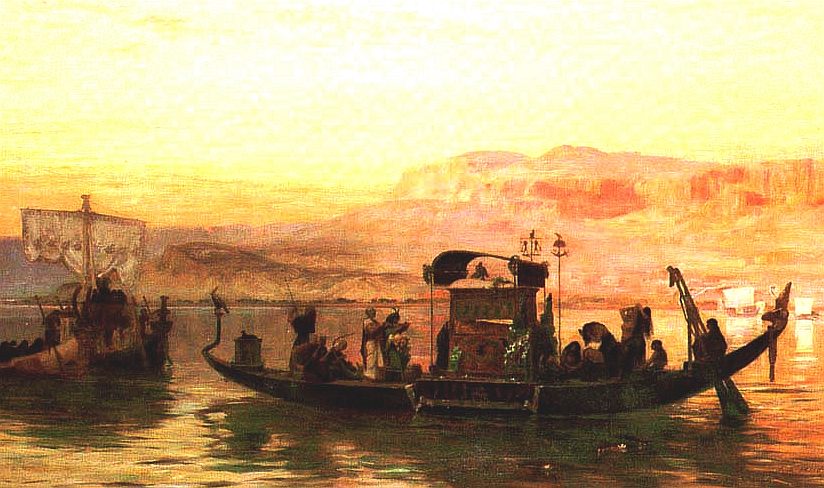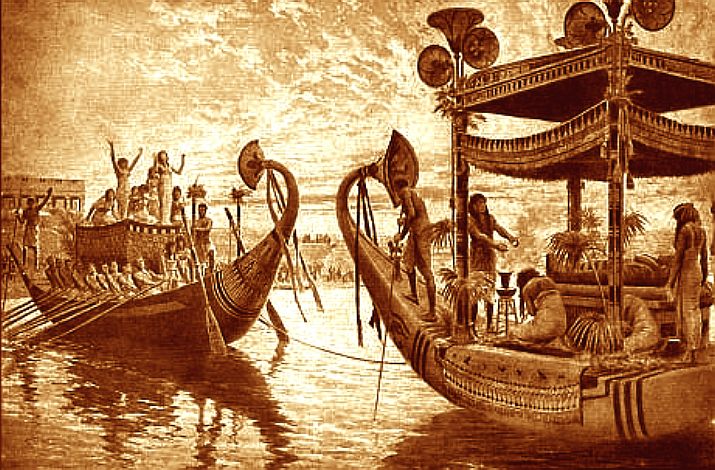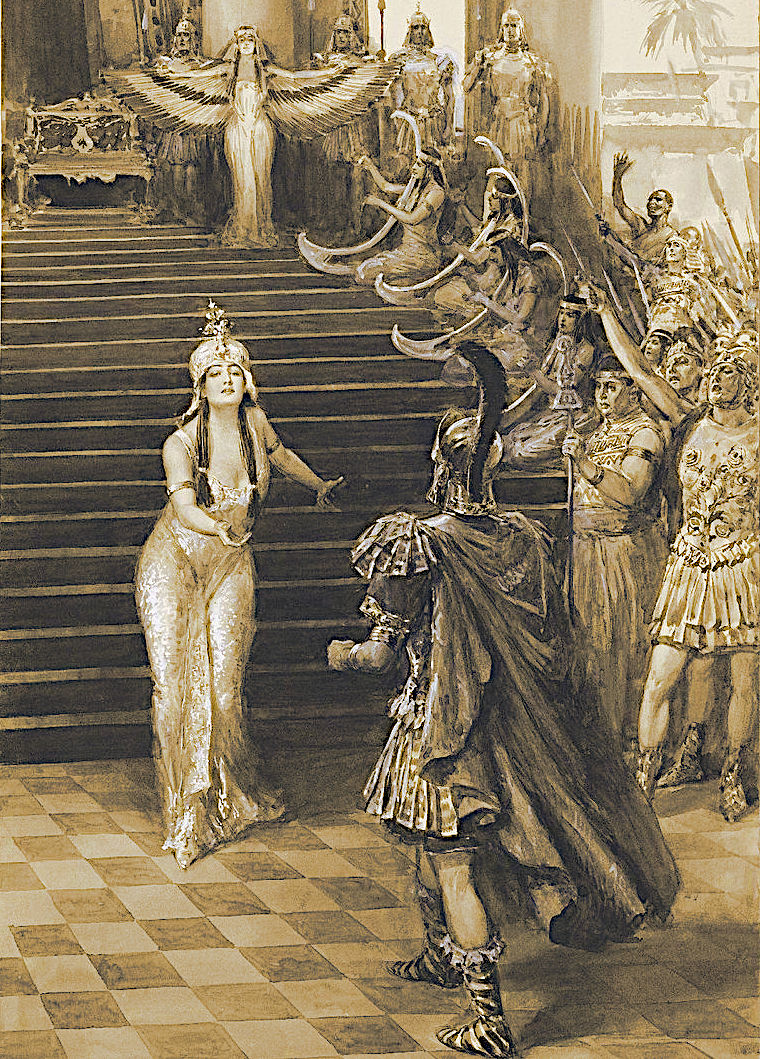|
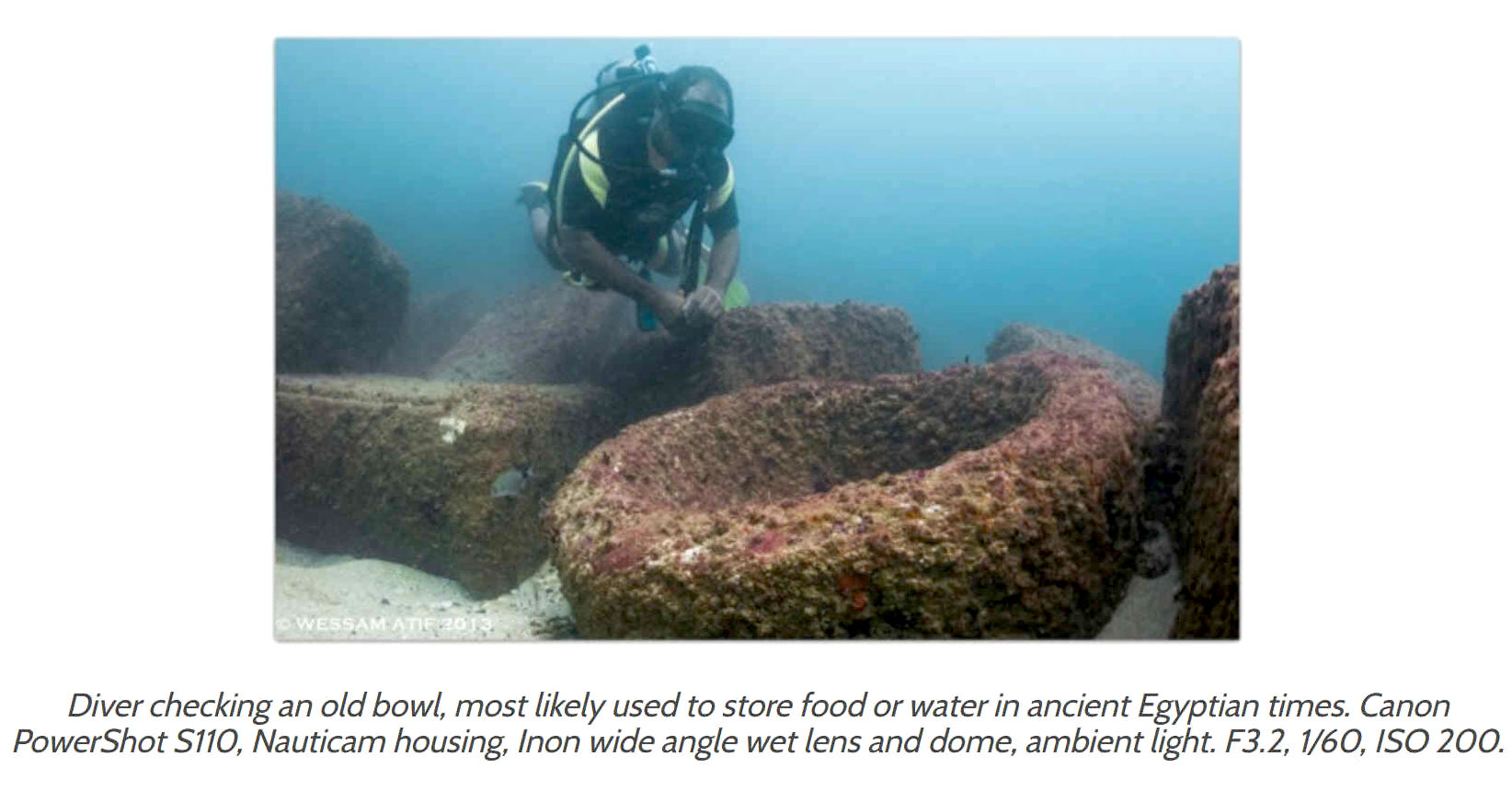
In
our story the Baron
Heinrich Richtohofen, John
Storm and Hal,
the AI onboard the Elizabeth
Swann, all agree that Cleopatra is entombed underwater in
her former Palace at Alexandria,
or at a special mausoleum
at Thonis-Heracleion - based
on a probability algorithm.
It seems we are not alone in this belief. For sure, the work
at Taposiris Magna is helping to build a picture of life
under Cleopatra, when hundreds of coins with her image and
other artifacts, confirm her as a revered ruler of her time.
We hope the scientific community will not mind us bending
history a little, in the interests of promoting archaeology
and marine biology as essential sciences - generating a
reliable data base - of the natural world and man's ascendancy. UNDERWATER PHOTOGRAPHY GUIDE 2018 - DIVING INTO EGYPTIAN HISTORY
The Rediscovery of Cleopatra’s Sunken Palace & Diving it Today
1400 years ago in Egypt there was a terrible earthquake and a huge
tsunami that hit the coast of the great city of Alexandria. It sank the island of
Antirhodos, taking down queen Cleopatra’s palace and
Alexandria’s old lighthouse, once a wonder of the ancient world.
Today we dive where Antirohodos Island once was, taking you on a journey to see and enjoy what’s left of
Cleopatra’s sunken palace under the sea of Alexandria. Or learn more about diving Egypt.
Site History
The city of Alexandria was founded in 332 BC by Alexander the
Great, conquering Egypt in a conquest to expand his vast empire. After Alexander’s death, Greek occupation of Alexandria lasted 300 years until the start of Cleopatra’s reign. Queen Cleopatra was a full-blooded Greek and a mighty Egyptian Pharaoh. Her palace was spectacular - a landmark and symbol or her power. She ruled Egypt and spent much time creating alliances with Roman leaders to keep them from occupying Egypt. Tragically, she took her own life when she felt her efforts were about to fail, thinking Roman invasion was imminent.
The earthquake and tsunami that sank the island of Antirhodos occurred a few centuries after Cleopatra’s death, destroying and scattering the palace under about 10 meters of murky water in a small bay. Little was known of Cleopatra’s palace until the 1990s, when French archeologist
Franck Goddio stumbled across the ancient writings of a Greek historian named Strabo. Strabo described the great city of Alexandria and the island of Antirhodos, which seemed to be located in a bay near by the city’s shore. In these writings Strabo also described
Queen
Cleopatra’s palace, built on that same island.
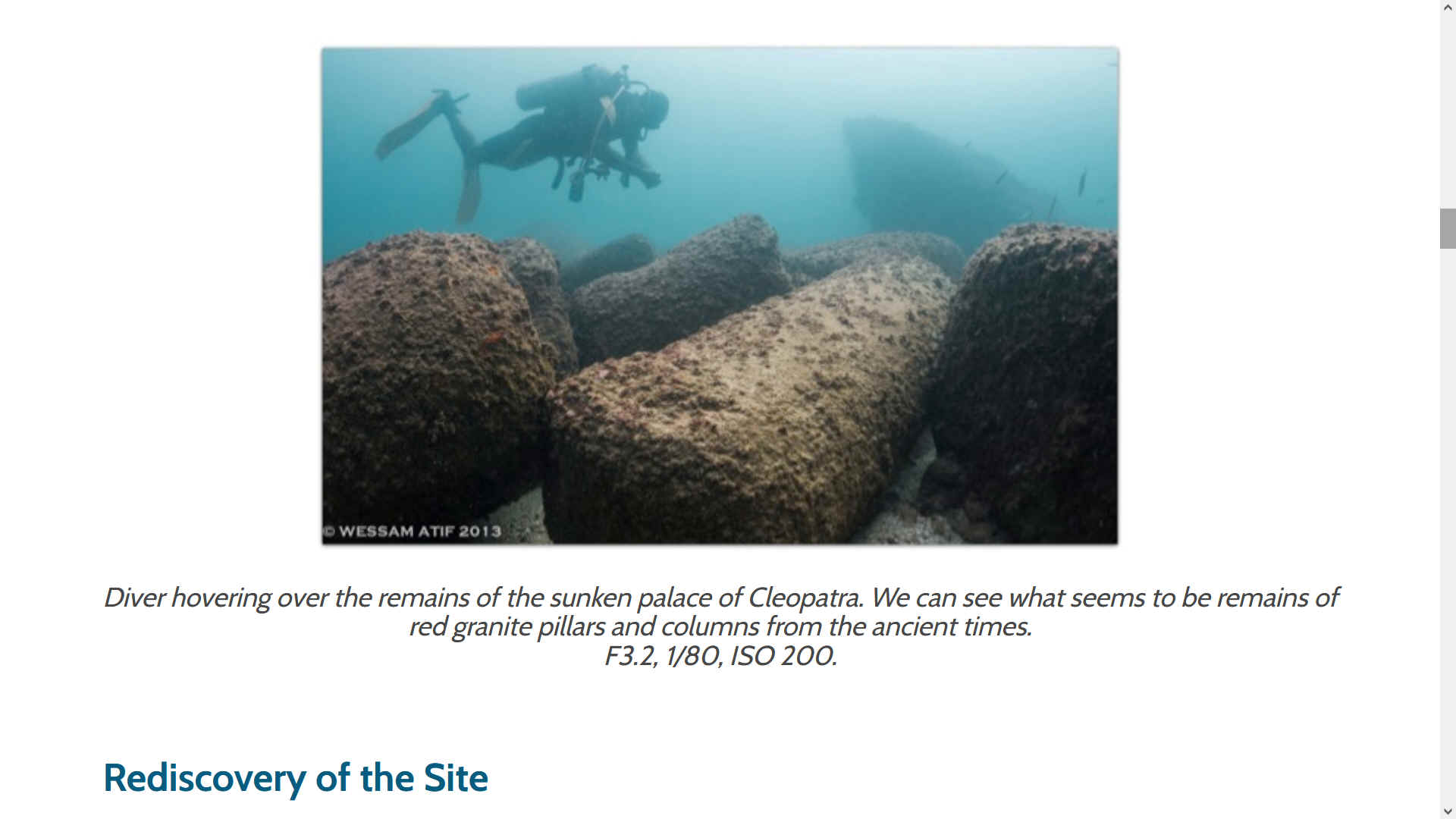
Rediscovery of the Site
Franck Goddio, who is also the President of the European Institute of Underwater Archaeology, spent 10 years planning an expedition to uncover the secrets of
Cleopatra’s sunken palace, determined to find and bring it back to light.
While exploring the sunken island of Antirhodos during the expedition, guided only by Strabo’s ancient descriptions, Goddio's team started to find clues: a wreck of an ancient cargo ship more than 30 meters long, jewelry, hairpins, rings and glass cups.
In the late 1990s, divers discovered the remains of ancient docks at the eastern side of the island as well as a series of giant columns/pillars made of red
Egyptian granite with shattered pottery beneath them. There were more than 60 pieces, each 4 feet in diameter and 7 meters in length.
Ancient paintings indicate the columns/pillars acted as a ceremonial gateway to the island. Each column had a decorated crown on top and together they created a magnificent entrance - one fit for a queen.
Inspired and dedicated, Goddio’s team finally found the wooden foundation of Cleopatra’s palace, carbon dating it to approximately 200 years before her birth. Because of this, Goddio believes Cleopatra inherited the palace. The team also discovered statues believed to be part of Cleopatra’s shrine/temple, a statue of her high priest and 2 perfectly preserved sphinxes (spiritual guardians of temples).
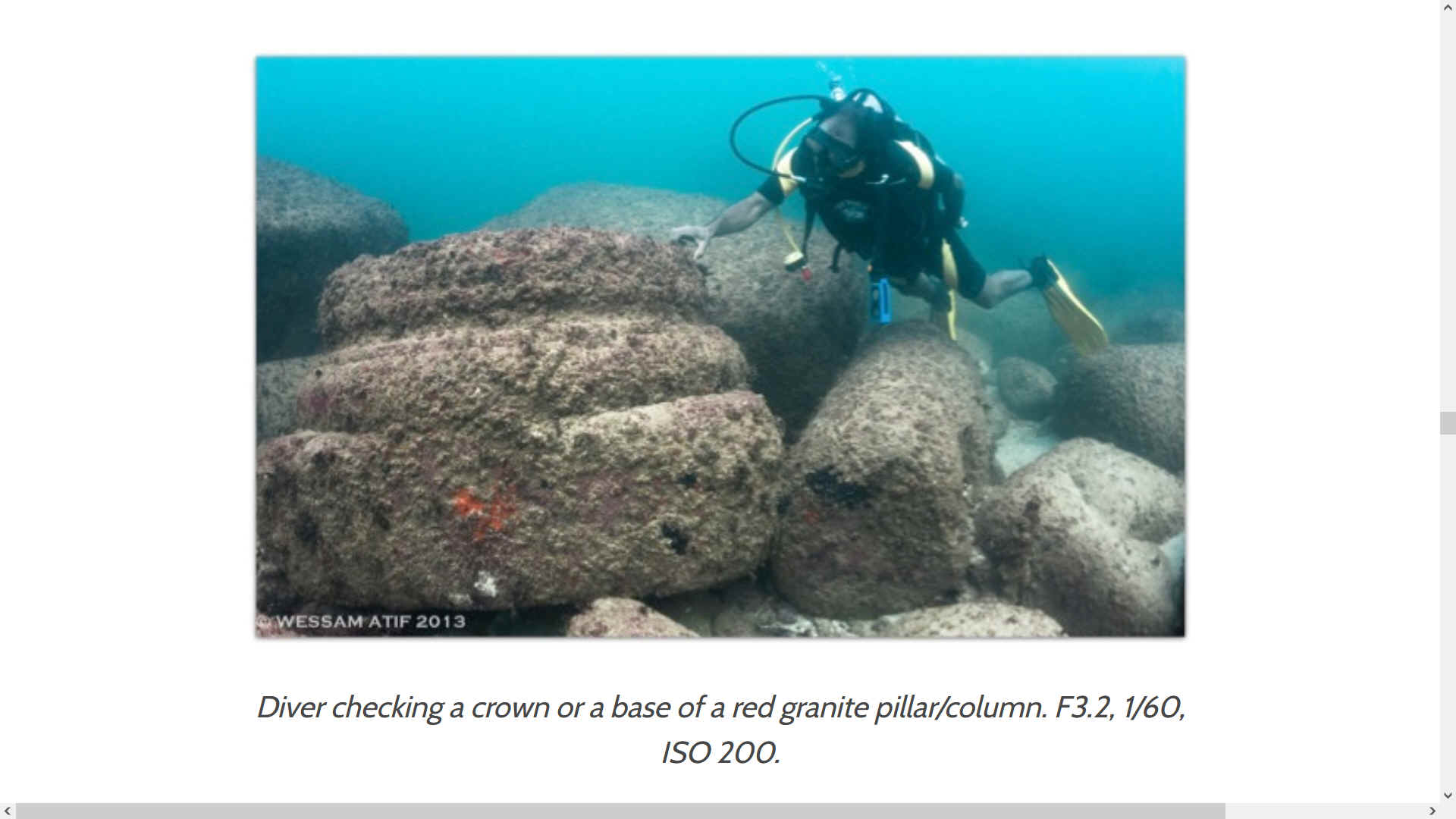
Diving Cleopatra's Palace Today
Unfortunately for divers, all the well-preserved pieces Goddio dug out have been taken out of the water to tour the world museums. These are the images you’ll see when searching for
Cleopatra’s palace on the Internet. The team took detailed photos of everything before lifting it, but that’s not quite the same as diving among the historic relics. That said, there are still some artifacts for divers to see today and you can feel the presence of history all around you underwater.
Diving the Mediterranean might take some getting used to if you only dive tropical water. Waves can be big and strong, while visibility is a serious issue that you should never underestimate, especially if you’re planning to take photos. Vis is less than 1 meter in some locations and a maximum of 4 to 5 meters on a good day. Sometimes you may even have to hold the hand of your dive guide during descent. It's well worth it though.
The site is really shallow, just 5 to 8 meters, which gives you plenty of bottom time. You can see many of the columns of the palace, huge stones everywhere, big bowls used in ancient times to keep
water or food and two Sphinxes.
The Sphinx that appears in the photos of this article had its head separated from its body. You may also see stones with ancient Egyptian writings on it if the visibility is good enough (by good enough I mean more than 2 meters).
In conclusion, diving Cleopatra’s palace is an amazing experience as long as you know what to expect. You will not see the detailed artifacts shown in museum photos, but you will find interesting diving in one of the oldest historical sites underwater. It’s an unforgettable dive experience.

ABOUT THE AUTHOR
Wessam Atif is an Environmental Health Doctor, originally from Egypt but living in the Philippines. His passion is underwater photography and diving, and he is fascinated by the history of Alexandria - once the greatest city in the world. His photography experience is 3 yrs and almost one year shooting underwater. Wessam's work has been published in Practical Photography Magazine, BBC wildlife Magazine and Gulf news.
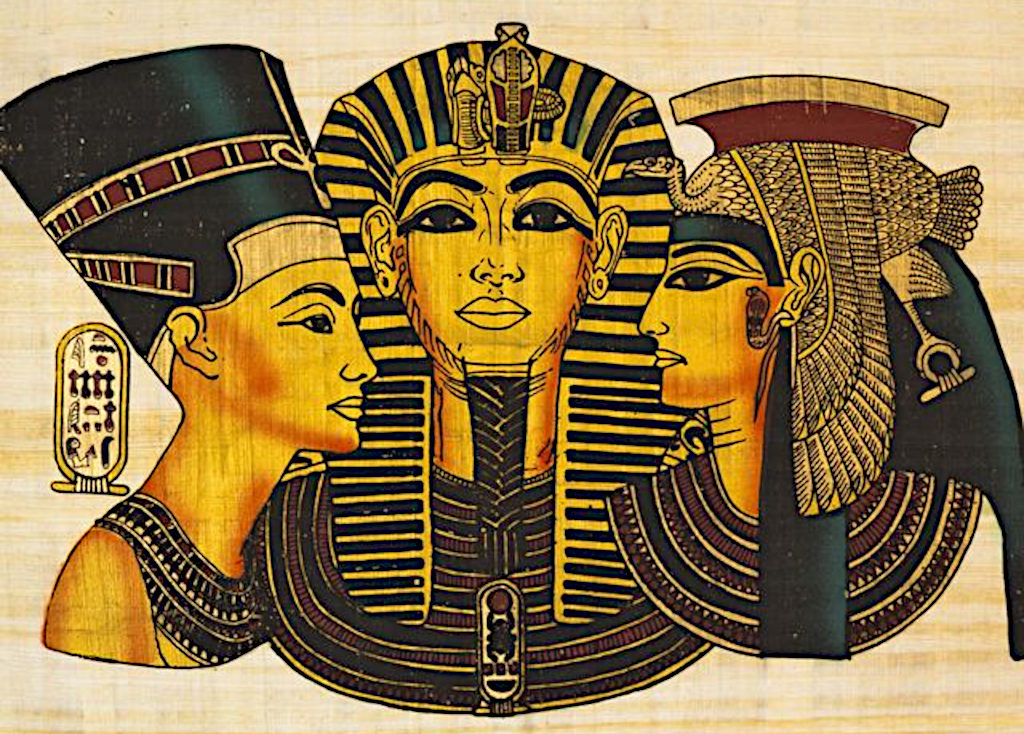
MEDIA
INDEX
BBC
NEWS - NETFLIX CLEOPATRA DOCUDRAMA 10 MAY 2023
BRISBANE
TIMES - RADAR REVEALS POSSIBLE LOCATION CLEOPATRA'S TOMB 2009
BRITISH
MUSEUM - CLEOPATRA,
17 YEAR OLD DAUGHTER OF CANDACE, THEBES
CAMBRIDGE
UNIVERSITY - STUDY
OF ANCIENT EGYPTIAN MUMMY DNA 17 MAY 2017, RELATED TO MIDDLE EAST
CBC
- CLEOPATRA OUTSMARTED EVERYONE, FEBRUARY 2021
CBS
- WHY
SOME EGYPTIANS ARE FUMING OVER NETFLIX'S BLACK CLEOPATRA
DAILY
MAIL - ADELE JAMES BREAK SILENCE AS TO BLACKWASHING CLAIMS MAY 2023
DAILY
MAIL - DEC
9 2024 KATHLENE MARTINEZ SEARCHING 20 YEARS MAKE SIGNIFICANT
FIND
DISCOVERY
MAGAZINE - JUNE
7 2023, WILL WE EVER FIND THE TOMB OF CLEOPATRA?
GREEK
CITY TIMES - ARCHAEOLOGIST CLAIMS TO BE CLOSE TO DISCOVERY OF CLEOPATRA
2021
LIVESCIENCE
- WHERE IS CLEOPATRA'S TOMB/PALACE JULY 2020
NATURE
- STUDY
90 MUMMIES REVEALS ANCESTRY ANCIENT EGYPTIANS: MIDDLE EASTERN JUNE
2017
ROTTEN
TOMATOES - CLEOPATRA
CRITICS, SERIES 1 REVIEWS MAY 2023
SKY
HISTORY - THE
HIDDEN TOMB OF CLEOPATRA MARCH 2023
SKYE
NEVILLE - PLASTIC FREE COMICS, WAITROSE BANS
SMITHSONIAN
- MORE
THAN HISTORIC SEDUCTIONS, REHABILITATED ELIZABETH TAYLOR, HOLLYWOOD ICON:
2010
SPECTATOR
- THE
TROUBLE WITH NETFLIX'S QUEEN CLEOPATRA 29 MAY 2023
STUART
GIBBS - CHARLIE
THORNE & THE CURSE OF CLEOPATRA - SIMON & SCHUSTER
REVIEW 2023
THE
CONVERSATION - WHY
THE DISCOVERY OF CLEOPATRA'S TOMB COULD REWRITE HISTORY 2022
THE
GUARDIAN - NETFLIX, NO NEED FOR WHITE ACTOR 10 MAY 2023
THE
SUN - QUEEN CLEOPATRA'S TOMB, TAPOSIRIS MAGNA 2020
THE
SUN - THE REICH STUFF: GLOBAL HUNT FOR HITLER'S LOST £20 BILLION NAZI GOLD HORDE APRIL 2021
UNDERWATER
PHOTOGRAPHY GUIDE - CLEOPATRA'S SUNKEN PALACE
USA
TODAY - MUSTAFA
WAZIRI, ALEXANDRIA, EGYPTIAN ARCHAEOLOGISTS 2018
YOUTUBERS
- MAKEUP,
CLEOPATRA'S FACE & EYE COSMETICS, MUMMY MASK
YOUTUBERS
- NETFLIX VIDEO COMMENTS MAY 2023
ZAHI
HAWASS - DOCUMENTARY: CLEOPATRA VII PHILOPATOR
https://www.uwphotographyguide.com/diving-cleopatras-palace
https://www.uwphotographyguide.com/diving-cleopatras-palace
|





